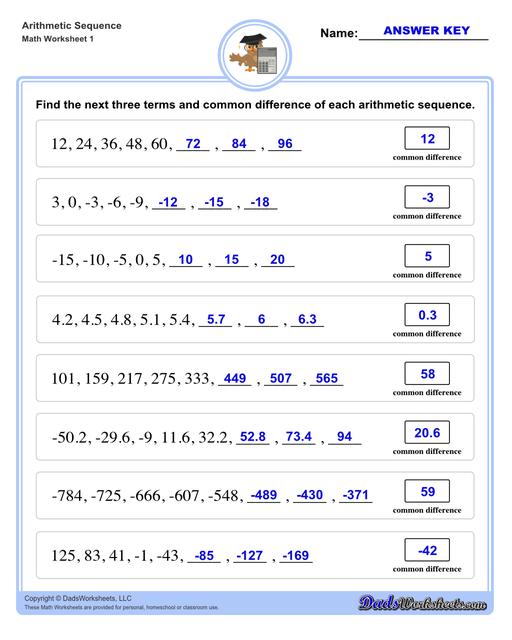

The 50 th term is found by setting n = 50 in the above formula. Use the value of the common difference d = 3 and the first term a 1 = 6 in the formula for the n th term given above Find a formula for the n th term and the value of the 50 th term The first term of an arithmetic sequence is equal to 6 and the common difference is equal to 3. An online calculator to calculate the sum of the terms in an arithmetic sequence.
#SEQUENCES MATH QUESTION SERIES#
The sum s n of the first n terms of an arithmetic sequence is defined byĪrithmetic Series Online Calculator. The formula for the n th term a n of an arithmetic sequence with a common difference d and a first term a 1 is given by is equal to twice the mth term.Arithmetic Sequences Problems with SolutionsĪrithmetic sequences are used throughout mathematics and applied to engineering, sciences, computer sciences, biology and finance problems.Ī set of problems and exercises involving arithmetic sequences, along with detailed solutions are presented. Show that the sum of (m + n)th and (m – n)th terms of an A.P. Using (2) and (3), we can deduce that the 18th term of the first AP divided by the 18th term of the second AP equals 179/321. Substitute 35 for n in equation (1), because (n-1)/2 = 17. On L.H.S, cancel out (n/2) both the numerator and denominator. (5n+4)/(9n+6) = (Sum of n terms of the first A.P)/(Sum of n terms of the second A.P)

Find the ratio of their 18th terms.Īns: Let the initial term and the common difference of the first and second arithmetic progressions be a_1, a_2 and d_1, d_2 correspondingly. The sums of n terms of two arithmetic progressions are in the ratio 5n+4: 9n+6. Let’s take A1, A2, A3, ………A2n be 2n arithmetic means between a and b The number of means inserted is then multiplied by two, thenĪns: Let’s take a and b are two numbers such that Between them, an even number of mathematical means are placed, and their sum exceeds their number by one. Let the Tr be the r th term of an A.P Series., for r = 1, 2, 3, … If for some positive integers m, n, we have Tm = 1/n and Tn = 1/m, then Tm n is equivalent toĪns: Let’s assume the first term is a has the common difference of d in the AP Hence, the product of the first five terms is 4^5 Now, the product of the first five terms can be defined as = a.ar.ar 2.ar 3.ar4, then The result of multiplying the first five terms isĪns: From the given question, it is given that T_3 = 4. A geometric progression 's third term is 4. ⇒ a 2, b 2, c 2 are in AP (or AP Series). If the numbers 1/(b + c), 1/(c + a), 1/(a + b) are in AP Series, thenįrom the given question, the numbers are, 1/(b + c), 1/(c + a), 1/(a + b) Solution: From the given question, the series can be defined as: Now, it is given that, the numbers a/r, 2a, ar are in AP Since the numbers form is increasing GP, So r > 1 Let’s assume the three numbers be a/r, a, ar The new numbers are in Ap if the middle term is doubled. An increasing GP is formed by three numbers. ⇒ d/a, e/b, f/c are in Arithmetic Progression (AP). So -b/a is the common root of the above quadratic equation. Hence, ax 2 + 2bx + c = 0 have equal roots.Īnd the root of the above equation is -2b/2a = -b/a If a, b, and c are all in G.P., then ax² + 2bx + c = 0 and dx² + 2ex + f = 0 share a common root if d/a, e/b, and f/c are all in G.P. The video below explains this: Sequence and Series Detailed Video Explanation:Īlso check: NCERT Solutions for class 11 mathematics Chapter 9: Sequences and Series

Unlike a set, order matters, and a phrase might appear many times in the sequence at different points. The length of the sequence is defined as the number of ordered elements (potentially infinite). It has members, just like a set (also called elements or terms). A sequence is an ordered list of items in mathematics. Important Questions for Class 11 Maths Chapter 9: Sequences and Series are provided in the article.


 0 kommentar(er)
0 kommentar(er)
